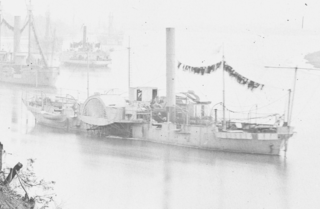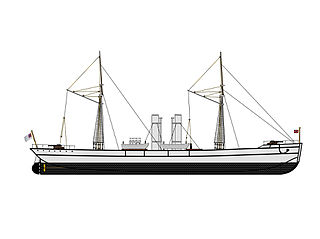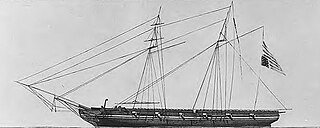USS A. J. View – a Confederate States of America schooner – was captured during the beginning of the American Civil War by the Union Navy.

The first USS Miami was a side-wheel steamer, double-ender gunboat in the United States Navy during the American Civil War.

Charles Williamson Flusser was an officer in the United States Navy during the American Civil War.

CSSEllis was a gunboat in the Confederate States Navy and the United States Navy during the American Civil War. It was lost during a raid while under command of famed Navy officer Lieutenant William B. Cushing.

USS South Carolina was a steamer used by the Union Navy during the American Civil War.

USS Commodore Perry was a 512-long-ton (520 t) steamer acquired by the Union Navy during the first year of the American Civil War.

The CSS Tallahassee was a twin-screw steamer and cruiser in the Confederate States Navy, purchased in 1864, and used for commerce raiding off the Atlantic coast. She later operated under the names CSS Olustee and CSS Chameleon.
The first USS Onward was a clipper in the Union Navy.

USS Satellite was a steam powered large tugboat, acquired by the Union Navy during the American Civil War and equipped with two powerful 8-inch guns. She was assigned to the Union blockade of the Confederate States of America.
USS Dai Ching was a steam gunboat in commissioned into service in the United States Navy in 1863. She served in the Union Navy during the American Civil War until her loss in 1865.
USS Shawsheen was a steam operated tugboat acquired by the Union Navy during the American Civil War.
USS Rosalie was a captured Confederate sloop acquired by the Union Navy from the prize court during the American Civil War.

USS Huntsville was a steamer acquired by the Union Navy during the American Civil War. She was used by the Navy to patrol navigable waterways of the Confederacy to prevent the South from trading with other countries.
USS Charlotte was a schooner captured by the Union Navy during the American Civil War. She was used by the Union Navy to patrol navigable waterways of the Confederacy to prevent the South from trading with other countries.
USS Annie was a schooner captured by the Union Navy during the American Civil War. She was used by the Union Navy as a ship's tender in support of the Union Navy blockade of Confederate waterways. Her service during the Union naval blockade of Confederate waters peaked during the Second Chesapeake Affair (1863–64) as a "fresh reinforcement from the south" in the search and capture of the U.S.S Chesapeake.
USS Gemsbok was a bark acquired by the Union Navy during the American Civil War. She was used by the Navy as a gunboat, but, later in the war, she was also used as a collier and as a storeship.
The third USS Union was a heavy (1,114-ton) steamer with a powerful 12-inch rifled gun purchased by the United States Navy during the American Civil War.
USS Susan Ann Howard was a schooner requisitioned from the prize court by the Union Navy during the Union blockade of the American Civil War.

The West Indies Anti-Piracy Operations refer to the United States Navy presence in the Antilles, and surrounding waters, which fought against pirates. Between 1817 and 1825, the American West Indies Squadron constantly pursued pirates on sea and land, primarily around Cuba and Puerto Rico. After the capture of Roberto Cofresi in 1825, acts of piracy became rare, and the operation was considered a success, although limited occurrences went on until slightly after the start of the 20th century.








